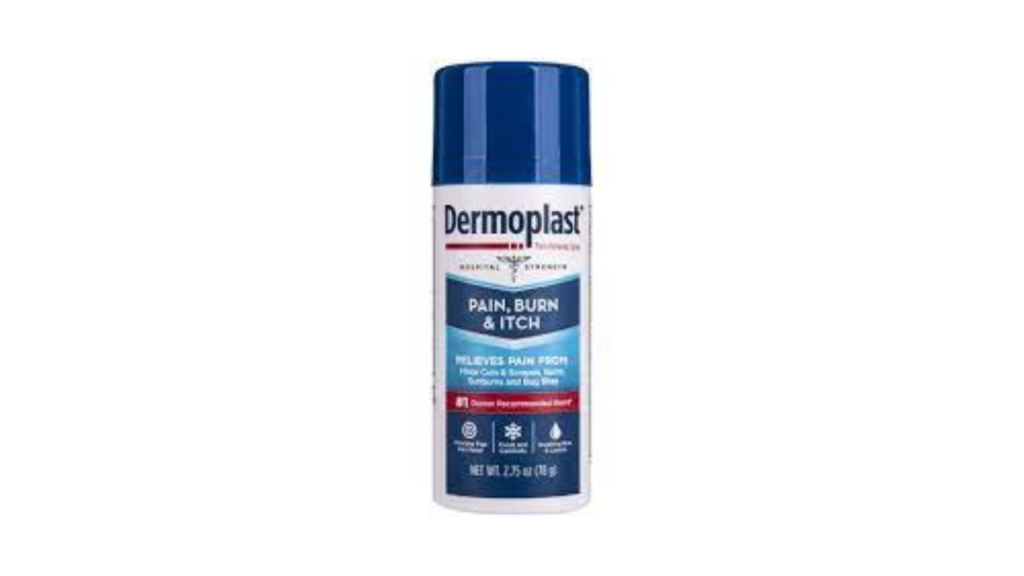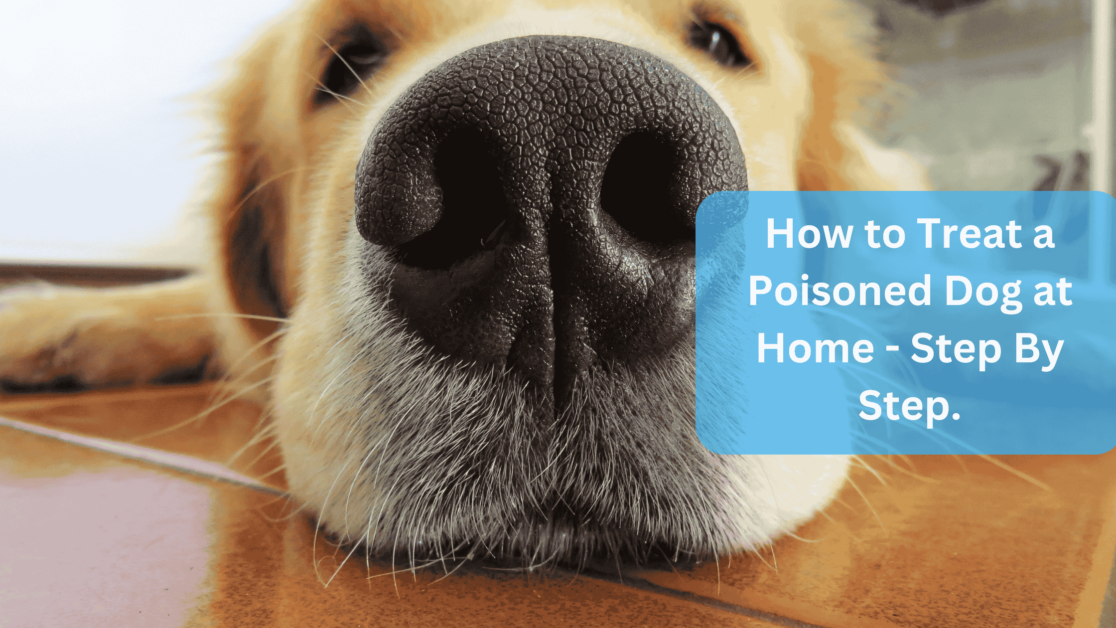You want to provide your furry buddy the finest care possible as a responsible pet owner, which includes attending to any discomfort or pain they might be feeling.
Dermoplast is a well-known numbing spray available over the counter that people frequently use to treat minor skin irritations and post-surgical pain in humans.
But Can you use Dermoplast on dogs? In this thorough guide, we’ll examine the potential application of Dermoplast to dogs while outlining its benefits, risks, and requirements for pet owners.
What is Dermoplast and How Does it Work?
Benzocaine, menthol, and occasionally pramoxine are among the active components in Dermoplast, a popular over-the-counter numbing spray.
It is frequently used in humans to temporarily relieve minor skin irritations, burns, insect bites, and post-surgical pain because it is primarily intended for topical skin treatment.
Dermoplast’s active chemicals operate by numbing the skin’s nerve endings, temporarily easing the pain, itching, and discomfort brought on by various skin conditions.
While pramoxine is well known for its numbing effects, menthol gives off a cooling sensation, and benzocaine is a local anesthetic that blocks nerve signals.
These compounds’ synergistic interactions provide momentary alleviation for modest skin pain.
Dermoplast is a topical skin care product in various formulations, including sprays and aerosols. It may include extra components like aloe vera, vitamin E, or other skin-soothing substances.
For the correct use, dosage, and safety precautions, it is crucial to read and abide by the instructions on the product label.
The use of Dermoplast on dogs or other animals has not been officially approved because it is designed for human use only.
It is essential to seek the advice of a licensed veterinarian before administering Dermoplast or any other drug to your dog because canines have distinct physiological distinctions from humans and may respond to medications differently.
Without a doctor’s prescription, using Dermoplast or any other product not made expressly for dogs comes with hazards and may even be harmful to your pet.
When considering using any product on your pet, always put their health and safety first and consult a licensed veterinarian.
Also Read: Can Chia Seeds Kill Dogs? Myth vs. Fact
Can You Use Dermoplast on Dogs?

It’s essential to put your pet’s safety and well-being first as a conscientious pet owner. It’s best to seek the advice of a licensed veterinarian before administering any medication or using any product on dogs.
Dermoplast is a topical anesthetic spray that has not been expressly authorized for use in dogs or other animals and is designed for use on humans.
Although the active components in Dermoplast, such as benzocaine, menthol, and pramoxine, are frequently used in human medications to temporarily relieve minor skin discomfort, it’s important to understand that dogs have specific physiological differences and may respond to medications differently than humans.
Without a vet’s consent, using Dermoplast or any other product not made exclusively for dogs on your canine companion may be risky and harmful to your pet.
Dogs might lick or eat the product, which could cause them to consume the active substances and have negative consequences.
Dermoplast contains substances that some dogs may be more sensitive to or allergic to, which might cause skin rashes or other problems.
Therefore, before considering using Dermoplast or any other product on your dog, it is strongly advised that you speak with your veterinarian.
Your veterinarian can guide you to ensure the safe and suitable administration of any drug or product for your furry friend, considering your dog’s health condition, age, breed, size, and other characteristics.
When considering using any product, including Dermoplast, on your dog, it’s crucial to put your pet’s health and well-being first and always seek competent veterinary guidance.
Your veterinarian is the ideal person to advise on how to administer medications correctly and take other suitable steps to ensure your dog’s comfort and health.
Risks and Considerations for Using Dermoplast on Dogs
Pet owners should know the hazards and considerations of applying Dermoplast or any other product to their dog without consulting a veterinarian.
Dermoplast is a well-liked topical numbing spray for humans.
However, there may be hazards and issues when using it on dogs.
Ingestion and Toxicity: When Dermoplast is applied to a dog’s skin, the animal may lick it off or ingest it, which could result in consuming active chemicals. If used in significant doses, some of the components in Dermoplast, including benzocaine, menthol, and pramoxine, can be hazardous to dogs. Negative consequences could include gastrointestinal distress, vomiting, diarrhea, or even more severe issues.
Allergic Reactions: Dogs can experience allergic reactions to some Dermoplast components like humans. Skin redness, swelling, itching, and even more severe reactions like anaphylaxis or difficulty breathing can all be signs of an allergic reaction. Suppose you do use Dermoplast or any other product on your dog. In that case, it’s crucial to watch out for any indications of allergic reactions.
Lack of Safety Information: Dogs or other animals cannot use Dermoplast because it was not created or approved. Dermoplast’s efficacy and safety for canine use have not been properly investigated or confirmed, and there may be little safety information available for its use on dogs.
Underlying Health Conditions: When using Dermoplast or comparable products, dogs with certain health conditions, such as open wounds, cuts, or skin infections, may be more susceptible to complications or unfavorable reactions. Before applying any product to your dog’s skin, it’s important to consider their general health and current medical concerns.
Veterinary Advice: As a responsible pet owner, it’s advisable to seek advice from your vet before applying any product—including Dermoplast—to your dog. Your dog’s age, breed, size, other considerations, and your veterinarian’s professional recommendations can all be considered.
They can help you avoid the risks of using Dermoplast on your dog by advising you on how to properly use medications or goods.
Dermoplast may be a well-liked numbing spray for humans, but there may be hazards and issues when using it on dogs.
It’s crucial to seek your veterinarian’s advice and always put your pet’s health and well-being first.
Your veterinarian is the best person to provide information on how to utilize medications safely and effectively for the comfort and health of your dog.
Also Read: Why Do Dogs Have Wet Dreams and How Often? Best Guide
Alternatives to Dermoplast for Dogs
There are several alternatives to Dermoplast for dogs that you might take into account. It’s crucial to remember that you should always check your veterinarian before putting any product on your dog to guarantee its safety and suitability for your dog’s particular condition.
Here are some possible canine Dermoplast substitutes:
Lidocaine Gel or Spray
Lidocaine is an effective topical local anesthetic that can be used to numb skin. It may be possible to get lidocaine sprays or gels designed for veterinary usage, which you can use for particular circumstances under your veterinarian’s supervision.
Calendula Cream
Calendula is a plant that is naturally anti-inflammatory and calming. When administered topically, calendula cream may aid in calming and soothing dogs’ itchy skin. Use pet-specific calendula cream and adhere to your veterinarian’s advice to be safe.
Aloe Vera Gel
Another all-natural remedy that could assist in soothing and moisturizing the skin is aloe vera gel. It can be applied topically on dogs with sunburn or minor skin irritations. Again, it’s critical to use aloe vera gel made especially for pets and to adhere to your vet’s advice.
Epsom Salt Solution
When dissolved in water, Epsom salt can provide a calming and restorative solution that may benefit dogs with minor skin irritations.
Under the direction of your veterinarian, you can prepare a diluted Epsom salt solution and apply it to your dog’s skin.
Prescription Drugs
Your dog’s skin condition may occasionally need that your veterinarian prescribes particular drugs, such as corticosteroids or antibiotics, which can help to reduce pain, inflammation, and discomfort.
Preventive measures
Sometimes, the best course of action is prevention. Taking precautions to avoid skin irritants, wounds, or other skin problems in dogs can be extremely important.
This can entail routine grooming, maintaining clean, moisturized skin on your dog, avoiding known allergens or irritants, and offering a nutritious diet.
In conclusion, there are several possible Dermoplast alternatives for dogs, but it’s crucial to speak with your veterinarian for the best advice.
Based on your dog’s ailment, age, breed, and overall health, your veterinarian can suggest the best solutions.
Giving your dog’s health and well-being top priority is important, and your veterinarian is the best source of guidance on practical solutions for their comfort.
Tips for Managing Skin Irritations and Pain in Dogs
It’s crucial to properly manage your dog’s condition and offer them treatment if they suffer from skin irritations or pain. The following advice could be helpful:
Consult Your Veterinarian: It’s critical to speak with your veterinarian before beginning any skin-care regimen for your dog. Based on your dog’s particular condition, health history, and breed, they can offer a correct diagnosis and suggest the best course of action.
Keep the Affected Area Clean: It’s important to keep irritated skin clean to avoid further irritation or infection. Your doctor may advise using a mild, pet-friendly cleanser or antiseptic solution to perform routine cleanings. Avoid using abrasive soaps or human products since they can further aggravate your dog’s skin.
Avoid Triggers: Identify and avoid any triggers that may be causing your dog’s skin irritation, especially if they are allergies or other irritants. Changing their food, forgoing particular grooming items, or preventing them from being around known allergies or irritants in their environment are examples of how to do this.
Provide Relief with Topical therapies: Your veterinarian may suggest or prescribe topical therapies like creams, ointments, or sprays depending on the degree of the skin irritation. Apply the remedies just as prescribed and pay close attention to your veterinarian’s instructions.
Use pain management techniques: Your veterinarian may recommend pain management drugs or methods, including oral pain relievers, local anesthetics, or cold compresses, to help manage your dog’s discomfort if they are both in pain and having skin irritations.
Prevent Your Dog from Scratching or Licking: Preventing your dog from scratching or licking will help alleviate the irritation on their skin. Use an Elizabethan collar or other suitable safety precautions suggested by your vet to stop your dog from licking or scratching the injured area.
Maintain a nutritious Diet: A nutritious diet helps improve your dog’s general immunological and skin health. Ensure your dog eats the balanced, wholesome diet your vet has prescribed for the best skin health.
Regular Veterinarian Checkups: Regular checkups with your vet can aid in locating and treating any underlying medical issues that may be causing your dog’s skin irritations or pain. Follow your veterinarian’s advice regarding your dog’s vaccination schedule, wellness exams, and other preventive care procedures.
Create a Comfortable Environment for Your Dog: Making your dog feel at ease might assist to relieve tension and accelerate recovery. Make sure your dog has a cozy, clean place to relax and recover. Avoid harsh weather, high humidity, and other environmental elements that could aggravate their skin condition.
In conclusion, controlling skin irritants and pain in dogs necessitates accurate diagnosis and treatment under a veterinarian’s supervision.
Your dog can experience relief and improve the health of their skin by heeding these recommendations and cooperating closely with your veterinarian.
Always put your dog’s health first, and talk to your vet about the best course of action for your pet.
Also Read: How to Stop Smegma in Dogs: A Step-by-Step Guide
Conclusion
In conclusion, dogs’ health and well-being must know how to treat skin irritants and pain. Without the correct direction from a physician, dogs should not be treated with Dermoplast, a regularly used topical therapy for human skin.
It’s crucial to speak with your vet for an accurate diagnosis and treatment strategy for the unique ailment that your dog is experiencing.
When applying Dermoplast or any other topical treatment to dogs, there are several dangers and factors to be mindful of, including possible side effects, allergies, and drug interactions.
Dermoplast for dogs is not the only choice to think about; there may be safer and more effective alternatives.
Keeping the affected area clean, avoiding triggers, offering pain management techniques, preventing scratching or licking, adhering to a healthy diet, getting regular veterinary checkups, and providing a comfortable environment for your dog’s recovery are additional tips for managing skin irritations and pain in dogs.
Always put your dog’s health first and consult your veterinarian for the best course of action. You can aid your dog in getting relief from skin irritants and pain, as well as improve the general health of their skin with the right care and treatment.







